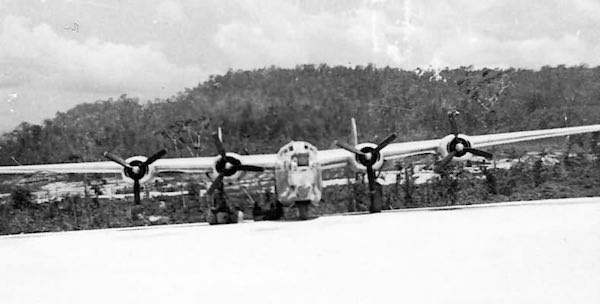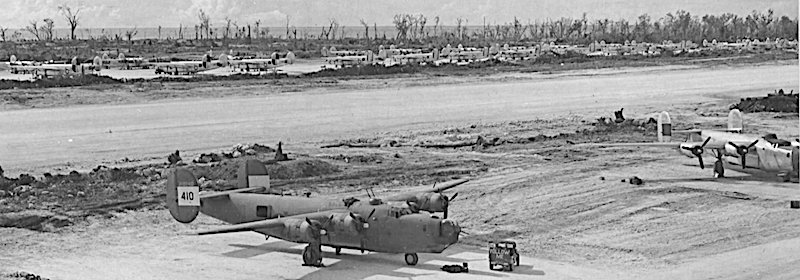
Lloyd H Bunting Jr, 1944
Pilot training
At a California flying school I was enjoying learning to fly but alas not well enough in the allocated 8 hours to continue with the training. Washed out was the expression.
Aerial gunnery training
Next I was unemployed in a dust bowl called Taft, California. What a place ! I haunted the bulletin board until another opportunity was posted "Volunteers for aerial gunnery training". This time to Las Vegas, Nevada, and at that I succeeded. But soon the waiting set in, and again I was checking the bulletin board.
Bombardier training
This time the offer was "Bombardier / navigator training". The new venue was Carlsbad, New Mexico.
I survived that so well I was asked to stay a while, as bombardier instructor, with the reward of another stripe on my sleeve. It was fun teaching my students to have good results and that anything but a perfect hit was always the pilot's fault.
Our bomb sight, the D-8 model as I recall, was very simple and the navigation was dead reckoning; OK for all short fast flights in medium bombers. After a few months the powers to be decided that the new Norden sighta> would replace the D-8 and navigation was celestial, for which only officers were qualified, so we enlisted personnel were displaced.
The Island Queen in Combat
The Island Queen was assigned to 408 Bomb Sqn in the 22nd Bomb Group, and was flown by Dwaine E. Harry. By coincidence, it was involved in Lloyd Bunting's mission from Wakde to Palau on 9 Jun 1944, described under the "Combat" tab. Story
Another 408 BS aircraft in that mission was ditched after being attacked by Japanese fighter aircraft. It ditched with the loss of 6 crew (KIA), 2 wounded (WIA) and 2 survivors. Story Story
Joining a crew
I was unemployed again, this time at MacDill Field, Tampa, Florida. Rather than just sitting around waiting for something to happen, I provided gunnery information to doctors, dentists, clerical officers, people who needed some knowledge "just in case". And I kept applying for a gunner's seat on any plane out.
One day I got the nod to join a bomber crew which was to train in El Paso, Texas. Here we trained as a crew.
Our new crew then went to Kansas where we were given a plane and all the gear, and continued getting used to each other and our aircraft, a B-24 Liberator.
One day, having attained suitable ability, all the crews were assembled in an auditorium where we were congratulated and advised that we were about to be assigned to theatres of combat.
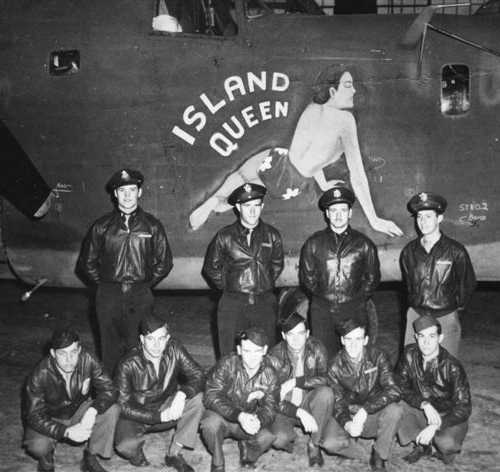
B-24J 80-CO 42-100230 "Island Queen" crew. Lloyd Bunting is in the front row at right.
There were about fifty B-24 crews there, in suspense especially since it was announced that the Air Force required only one replacement crew for the Western Pacific Theatre. Lots were drawn and would you believe our crew won the trip west. I say "won" because we had to listen to British and Yankee veterans telling us how it "is" over there in the East, which we took to mean cold and dangerous, whereas in the South West Pacific it isn't even cold.
General Kenney Converts The 22nd Bombardment Group from B-25 to B-24
"The B-24 production was in excess of European requirements, so I got General Hap Arnold to let me turn my 22nd Medium Bombardment Group, then equipped with B-25s, into a heavy group. As I was short B-25s to equip my other medium-bombardment groups, I proposed to use the 22nd Group’s air planes to help out that situation. The A-20 light-bomber production also was more than taking care of European needs, so it was agreed to equip my 312th Light Group with A-20s, to take the place of the P-40 fighter planes they had been using, and let me turn over the P-40s thus made surplus to the Australians, who needed them to keep their fighter units in aircraft. As long as the subject of the RAAF had come up, I proposed that, as we had an apparent surplus of B-24s pouring out of Ford’s Willow Run plant, I would like to have the RAAF organize seven heavy-bomber squadrons as fast as we could give them the bombers and they could train the crews. I offered to help out by lending them six B-24s immediately and helping the Aussies on the training end as well. Arnold agreed to let them have twelve B-24s in May 1944 and send them six a month, beginning in July, 1944. That would allow me to take the 380th Heavy Group out of Darwin, from where it was then bombing targets (eg Balikpapan oilfields) in the Netherlands East Indies, and move it north to increase the punch of the Fifth Air Force. Australian B-24s, as fast as they could go into combat, would replace the American B-24s in that work."
Source: "General Kenney Reports", pp 340-341
Deployment: Australia, New Guinea and further North
Cutting this tale shorter, on the 1st of January 1944 we left San Francisco for Hawaii, then onto Canton Island, Fiji, New Caledonia and Townsville Australia.
There, heavens knows why, we were relieved of our plane and all our gear and a short while later we were assigned to the 2nd Squadron, 22nd Bombardment Group (Heavy), 5th Air Force stationed in Port Moresby where the squadron was transitioning from B-25 medium bombers to B-24 heavy bombers.
Well, we were replacements and despite all the training we never flew with each other as a crew again.
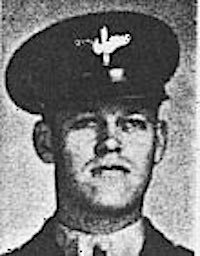
Lee M Shelton
Crossing the Pacific, Col Lee M Shelton (Pilot)
"By way of introduction, I was assigned to the 33rd Sqdn. and arrived in Australia during January of 1944 with the first contingent of B-24 aircraft and crews. We signed over the new aircraft to the depot at Townsville (Garbutt Field) and were transported to join the 22nd Gp at Charters Towers where the 22nd was undergoing transition from B-26/B-25s to the Liberator. After a bit of transition and orientation the outfit began moving to Nadzab, New Guinea, about mid-March, with combat missions beginning soon thereafter. We progressed through Wakde, Owi, Angaur, Samar (Leyte), P.I, and Clark Field ...
"For the record, there were 52 crews shipped out of Biggs Field, El Paso, TX on 12 Dec 1943, bound for Topeka, to pick up our new aircraft for ferry to the European theater. All went according to plan, such as route briefing, issue of high-altitude (sheep-lined) flying gear, assignment of aircraft, etc, even to a tentative departure date.
"Suddenly, late one night, we were called to a briefing and told that some of us were going to the Pacific, but quick. Some 30 crews took off, in new aircraft, during the next 48 hours, for Tucson, AZ (installation of long-range fuel tanks), then McClellan Field, CA (to flush and check the tanks), and finally to Fairfield-Salsun Army Air Base, CA (to tell us how the tanks work and how to find Australia).
"On the 9th of January 1944, we looked down from a midnight sky to see the Golden Gate Bridge pass beneath our wings. Did it ever look black over the water! Later, Hickham, Canton Island, New Caledonia, and finally the red tile roofs of Brisbane.
"'No - you guys don't belong here. Go on up to Townsville, they'll take your airplanes there.' Sure enough, they took our aircraft - and we turned over our sheep-lined flying gear. Said we wouldn't need it over here. How right they were!
"I learned after the war, while reading General Kenny's book, that he had persuaded General Arnold to spare him a few crews from the masses being assigned to the push in Europe. There but for the grace ...."
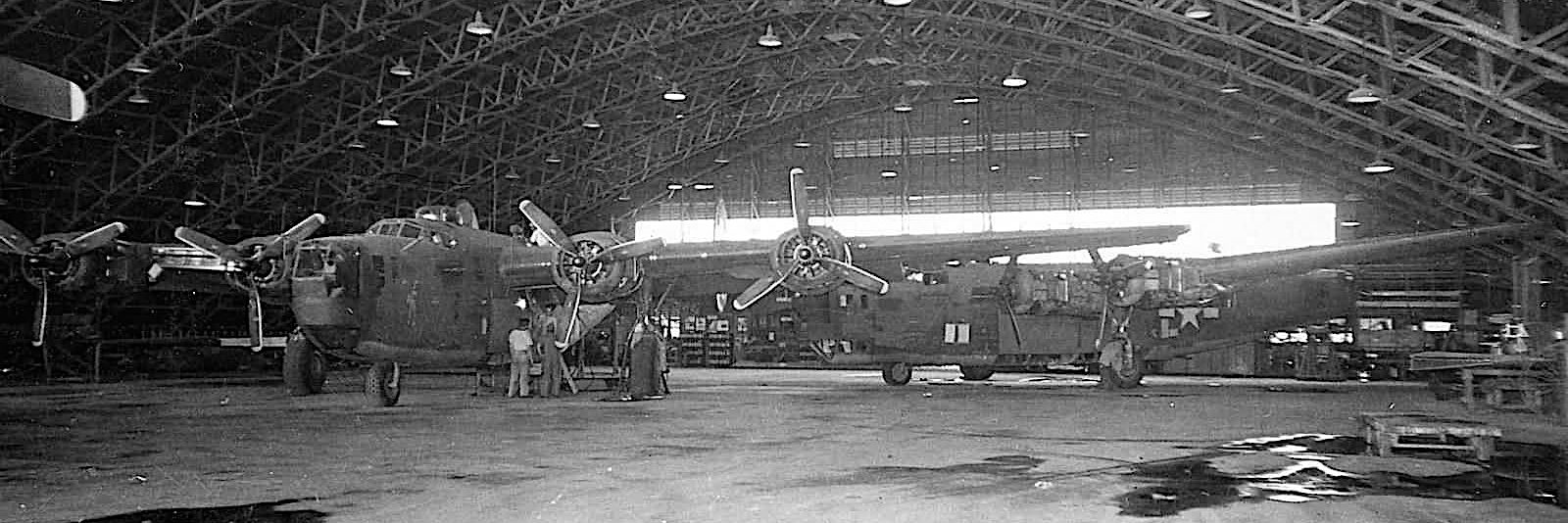
B-24 aircraft at Townsville, Feb 1944
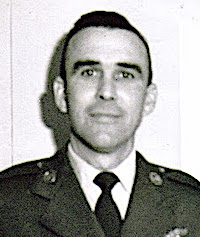
Hager Blair (28 Dec 1924 - 12 Apr 2013)
Letter from Hager Blair to Lloyd Bunting, 27 Oct 1982
"I remember our transition (from B-26) to B-24's very well at Port Moresby, your crew Darrel Prindle (pilot), Carpenter, Scott, Alar, Cameron Benson, and others came with the first B-24 crews. So I remembered all the people from the first B-24 crews - in fact as soon as I saw a picture I recognised all your crew I couldn't put a name in the right place but all the faces I recognised. We flew an 18 hour mission from Owi to Borneo and your Eng - Murphy was the Eng and Keith Whitney was the Nav (that one was a dilly). Story
I will give you a rundown on my 2nd Squadron history. We joined the 2nd at Reid River September 1943 - went to Dobodura then to Nadzab - of course to Owi - I finished my flying on Owi 26 Oct 1944. Was put on an LST and off to Leyte to set up a base for the Squadron. The idea was abandoned after the steel matting sank back into the mud - and the day after I left the Jap paratroopers took back the strip. After that I came back to Angaur - from Tacloban and then to Biak and caught a slow boat to 'Frisco.
Some of the things I remember about the bases in New Guinea:
- Dobodura was a very nice camp we had set up - saw my first big air fight there. Some of us were detailed down to Oro Bay to unload ammunition when about 20 Jap dive bombers arrived - well it was quite a show with the P-38s after them - and it got us out of the detail.
- Nadzab mosquitos and the razor sharp kuni grass. When the wind was blowing you could look up the slopes of the hills and the grass waving in the wind looked like waves on the ocean.
- Owi, a very pretty little place with the very crystal clear water - I spent much-much time in the water there.
- Leyte - lousey
- Angaur - only stopped there to pick up my orders (was nice and clean and dry)
The worst place I was at was on Leyte - there was no place that mud wasn't knee deep - and the fighting was going on everywhere - I was glad to get the hell out of there.
I got into communications and electronics after WWII, stayed in the Air Force for 22 years then went to work for the Space Agency (NASA) on communications and the weather satellites for about 15 years."
Pacific operations
I did 47 combat missions before being assigned for retraining in next generation bombers (B-29 [22nd BG, Korean War]) back in the U.S. This was from Clark Field, Manila. However Brisbane, Australia was the last stop for me because, while waiting in Brisbane for transport to the U.S., "VJ" arrived.

Lloyd's service record shows that he was assigned to the 22nd as an Armoror Gunner in B-24 heavy bombers with the 2nd Bombardment Squadron, 22nd Bombardment Group (Heavy), Fifth Air Force, South West Pacific Area on operations in China, Luzon, Southern Philippines, New Guinea, and the Western Pacific, including Palau.
He was awarded the Air Medal with 3 Oak leaf Clusters, the Asiatic Pacific Service medal, the Philippines Liberation Ribbon with Bronze Star, and the World War II Victory medal.
The Squadron jacket:

A later Squadron jacket:
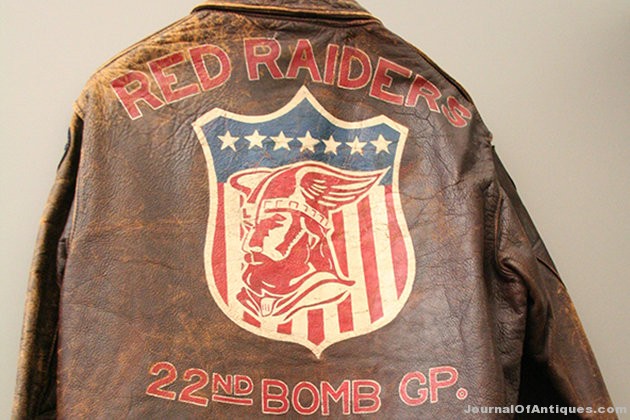
This jacket was originally acquired by 22nd Bomb Group pilot Robert Arand in the Philippines "for a packet of cigarettes" Story
The 22nd Bomb Group Jacket
The crew gets their prized jackets with squadron insignia and patches.
Lloyd Bunting is third from the left - with cigarette
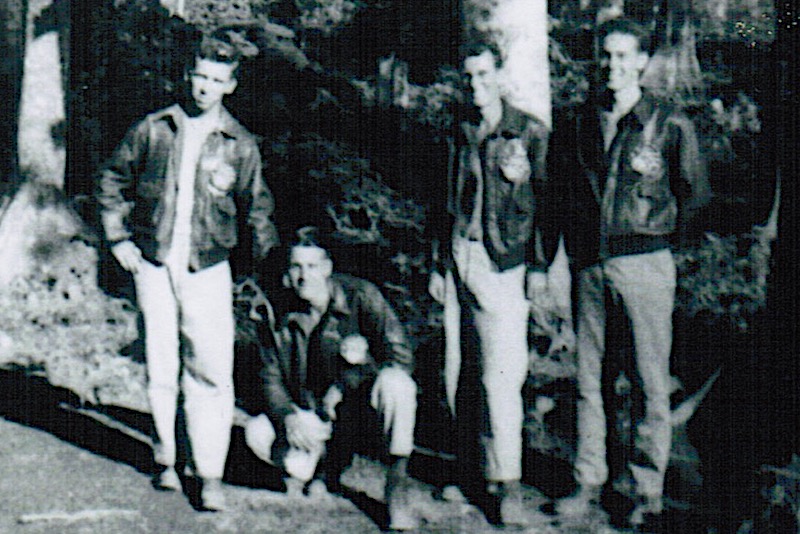
Lloyd Bunting is at right of the group.
Life in the 22nd Bomb Group in the Pacific
Film of life in the PacificThis is a remarkable film shot by Lt Robert Arthur (Art) Lint (ASN O-797151) of the 33rd Bomb Squadron in the 22nd Bomb Group Watch
It shows life in the air and on the ground in New Guinea (Nadzab), Owi, Angaur. The film was put together by Matt Barnes, nephew of B-24 pilot Art Lint. Lint was killed, along with 10 other crew on 1 Sep 1944, when it ditched about 15 miles from the coast of Mindanao, in Davao Gulf near Cape San Augustin.
The 2nd Squadron's club
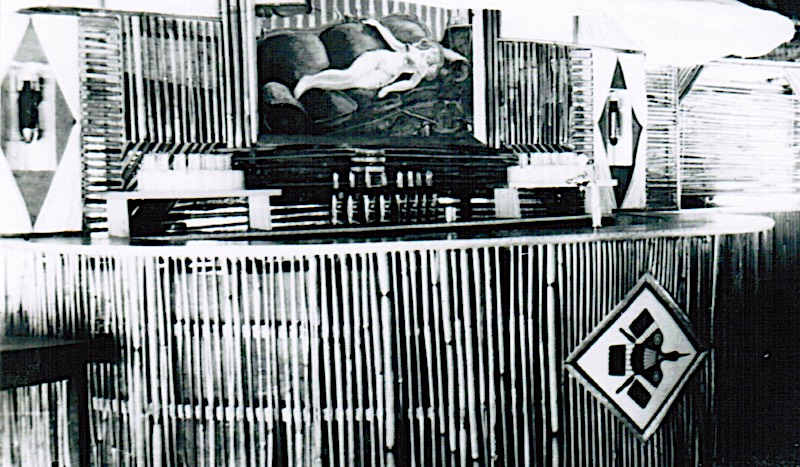
Lloyd's crew receives a visit

Lloyd Bunting is nearest to the camera, B-24 in the background.
War stories
These stories are from correspondence to Lloyd Bunting, and articles, from fellow squadron and crew members
Keith B. Whitney (Bombardier)
Mentions: Pilot Darrel Prindle, Co-Pilot Harold Heighton, Bombardier Keith Whitney, Armorer Pike, Nose Gunner Lloyd Bunting"Because I was the bombardier, I worked closely with Bunting and Pike who handled the armaments. Loading the bombs etc. I remember one mission where the bombs got hung up. We three had to physically kick them out. It was a little risky. Later the awards officer wanted me to write up the experience so he could submit it for an award and medals. I put it off not looking for glory. Finally after he dogged me for the story so I wrote it up like a melodrama and gave it to him. Needless to say he didn't submit it." (5 Nov 2005)
Bob Hope visits Owi Watch
